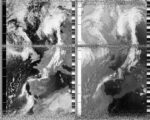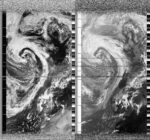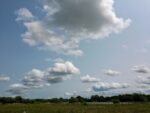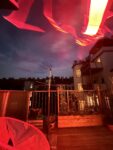2025-07-03 11:26:07
Richard A Carter
University of York, Campus East, United Kingdom
United Kingdom
NOAA-19

As a glider pilot, the sky today was wondrous: an ocean of large, fluffy white clouds with flat dark undersides, spreading from horizon to horizon - a clear sign of substantial thermal activity. The UK specific RASP weather model rated today five stars throughout the entire day - the star rating being the cumulative predicator of all the factors that can generate 'lift' for any soaring flight, with five being the very highest. Indeed, a glance at Flight Radar indicated that nearly every glider going was soaring UK skies today. The necessities of work meant that I could not join them, but an enjoyable sounding of NOAA 19 all the same, albeit marred by noise.
2025-06-03 12:35:18
Richard Carter
University of York, Campus East, United Kingdom
United Kingdom
NOAA-18


I've been reflecting recently on how my relationship with the atmosphere has changed since becoming a glider pilot. Different patterns and shapes of cloud are now read as resources for staying aloft, even on the ground. The photograph alongside this entry neatly illustrates a promising 'gliding sky' - large clouds with dark, flat undersides, and fluffy tops: all of which indicate potential for lift below. In particular, the clouds are forming a noticeable 'line of energy', that can be followed like a road, hopping from one source of lift to another. However, the one key aspect not captured here is the wind, which today would put paid to any flying - guests up to 32kts, which would exceed the safe takeoff and landing limits of any glider. Even if the wind was slightly lower, the strong drift would present a challenge for local soaring - hard to stay the course. Finally, there are sharp scuds of rain, which is always unwelcome, especially when airborne.
Today's NOAA imagery showcases the source of all this atmospheric energy very well, and I am very pleased to be on the ground!
2025-03-21 12:25:30
Richard A Carter
University of York, Campus East, United Kingdom
United Kingdom
NOAA-18

Software problems caused frequent glitches in the audio stream, resulting in this rather "striated" sounding, despite an otherwise excellent signal. A reminder, if there ever was, of the fragile chain of material structures and processes that enable these activities - and of how this fragility emerges from their status as constantly performing 'agents' in the world, rather than the typical image of technology as always fully tamed, always fully obedient to human imperatives.
2024-08-18 21:56:16
Soph Dyer
Lacknergasse, Wien, Austria
Austria
NOAA-19





There was a big electrical storm this evening. Bolts of lightening flashed between clouds for hours. As I have spent most of my time indoors over the last two weeks, so to witness this weather event, even from the window, was exhilarating. My recovery from the surgery has been uneven and absolutely nonlinear. I have moments of pure joy, such as when I woke from a nap feeling completely rested, my mind loose but still. But by the afternoon, I miss physical exercise and social contact. I know that I need to ride out this turbulence. Or rather ride with it.
NOTE: I received the satellite image after the storm had passed and the stars were out.